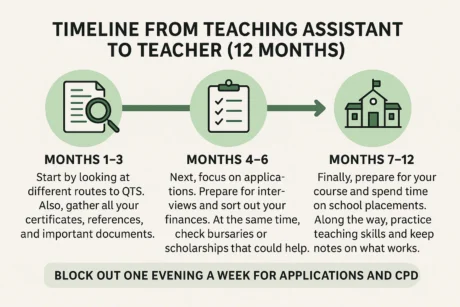You’re already helping students daily as a Teaching Assistant—but maybe you dream of running your own class. It can feel like a big jump, but becoming a teacher is easier than you think. If you want to know how to become a teacher from teaching assistant, the first thing you need is QTS. Once you have it, you can start as a qualified teacher in 2025/26 with a salary of £32,916+ outside London, and even higher in London.
In this guide, we’ll walk you through everything: routes to get QTS, entry requirements, bursaries and funding, apprenticeship salaries, tips for applying, and CPD courses like Unified Course. There will be no tricky words or confusion—just simple, friendly advice.
By the end, you’ll know exactly how to move from Teaching Assistant to Teacher in the UK—without stress, worry, or feeling lost.
Teaching Assistant to Teacher UK: Start Here in 2025

If you’re ready to take the next step, the starting salary for new teachers with QTS in 2025/26 is £32,916+ outside London, and higher in London. Plus, salaries increase steadily as you gain experience, and after five years, you could earn over £45,000 outside London.
Do this: First, think about which route suits you best. You could choose a bursary-funded route, which helps with money while you study. Or try a salaried route, like a teaching apprenticeship, where you earn while learning. Next, make sure you meet the entry requirements. Then, gather all your certificates and documents. Finally, plan your application timeline so you feel ready and confident. Step by step, you’ll be closer to leading your own class.
How to Become a Teacher From Teaching Assistant
There are a few ways to take the next step:
- PGCE + QTS (University-led): This takes about 1 year. You’ll spend time in schools on placements and also learn teaching theory at university. Plus, some subjects offer bursaries to help with costs.
- SCITT (School-Centred): This is practical, hands-on training in schools. You’ll have a mentor to guide you and get real classroom experience from day one. Some SCITTs even pay a salary while you train.
- Postgraduate Teaching Apprenticeship: Here, you earn while you learn. Salaries usually range from £22,601 to £40,994, depending on where you are. You’ll combine teaching in a school with formal training.
- Assessment-Only QTS: If you’re an experienced TA, this lets you get QTS quickly. You’ll need to show evidence of your teaching skills, and fees usually range from £1,500 to £4,000.
So, Pick 2–3 routes that suit your money, time, and lifestyle. Consider whether you want to earn while training or focus fully on studying. This way, you’ll feel confident and ready to start your journey.
Thinking of starting as a teaching assistant first? Our 10-step guide on How to Become Teaching Assistant shows the entry routes, training options, and qualifications you’ll need.
Key Requirements to Train as a Teacher in the UK
If you want to train as a teacher, there are a few important things you’ll need:
- GCSEs: You need English and Maths. For primary teaching, you usually need Science too. Some routes may ask for higher grades.
- Degree: Most routes need a degree in any subject. For some secondary subjects, like Maths, Science, or languages, a relevant degree is needed.
- Safeguarding checks: You’ll need an enhanced DBS check, references, and proof that you can work in the UK.
- Health & fitness: Some schools may ask for a simple health check to make sure you’re ready for classroom work.
- Experience: While not always required, having some school experience or TA work can help your application.
So, the next step is to gather all your certificates, references, and IDs in one folder. Also, make a note of any school experience you have. Being organised now will make the application process much easier and less stressful—and you’ll feel ready and confident to take the next step.
Teacher Training Bursaries and Scholarships in 2025/26
If you’re thinking about how to pay for teacher training, some bursaries and scholarships can really help—depending on your subject. For example:
- £29,000 bursaries for chemistry, computing, maths, and physics.
- £26,000 bursaries for biology, geography, design & technology, and languages.
- £10,000 bursaries for art & design, music, and RE.
- £5,000 bursary for English.
- Scholarships are also available in priority subjects, up to £31,000.
Also, some bursaries are only for certain courses, like PGCE or SCITT. Plus, the money usually comes in regular payments during your training, helping with living costs. And, if you’re training in a subject that’s in high demand, you may even get extra top-ups.
So, the next step is to find out which funding band your subject is in before applying. This way, you’ll know exactly what support you can get and feel confident as you start your journey to becoming a teacher.
Teacher Salaries in the UK (2025/26 Updated)

Once you have QTS, the starting salary for new teachers in 2025/26 is £32,916+ outside London, and higher in London. Over time, pay grows steadily. After five years, teachers can earn around £45,352 outside London, and even more in London.
In addition, you may get extra payments, such as London weighting or bonuses, for teaching shortage subjects such as Maths or Science. Pay also increases with promotions, extra responsibilities, or leadership roles.
Good news: Teachers in England will receive a 4% pay rise from 1 September 2025, which applies to all pay ranges. Extra funding will also help schools cover the costs.
So, do this: Write down your “break-even” monthly figure—including rent, bills, travel, and other costs. This way, you’ll know what you need to earn and can plan your journey to becoming a teacher with confidence.
Unqualified Teacher Pay and Apprenticeship Salaries (2025/26)
If you’re thinking about training while working, it’s helpful to know the pay for unqualified teachers and teaching apprenticeships. For example:
- England (outside London): £22,601–£35,259
- Outer London: £26,789–£39,450
- Inner London: £28,343–£40,994
Also, apprenticeship pay depends on your school, experience, and region. Plus, unqualified teachers still get holiday pay and pension contributions.
So, here’s what to do: Compare these salaries with any bursary you might get. This way, you can decide which path—earning while training or getting funded support—fits your lifestyle, money situation, and long-term goals best.
Timeline From Teaching Assistant to Teacher (12 Months)

Becoming a teacher from a TA can feel big, but step by step, it’s completely doable.
- Months 1–3: Start by looking at different routes to QTS. Also, gather all your certificates, references, and important documents.
- Months 4–6: Next, focus on applications. Prepare for interviews and sort out your finances. At the same time, check bursaries or scholarships that could help.
- Months 7–12: Finally, prepare for your course and spend time on school placements. Along the way, practice teaching skills and keep notes on what works.
So, do this: Block out one evening a week for applications and CPD. That’s how you’ll stay organised, feel confident, and move step by step toward your dream of becoming a teacher.
How to Apply for Teacher Training in the UK
Applying for teacher training can feel a bit scary, but step by step, it’s very possible. First, go to DfE Apply or the course provider’s website and check the deadlines carefully. After that, write a short personal statement—just 2 paragraphs—explaining why you want to teach and the difference you’ve made as a TA.
Also, mention any special skills, like helping SEN pupils or leading small groups. Then, organise your references, certificates, ID, and DBS check early so nothing holds you back. Next, double-check your application and submit it on time. By doing all this, you’ll feel confident, organised and ready to take the next step toward becoming a teacher.
CPD Courses for Teaching Assistants Becoming Teachers
Why CPD Matters
If you want to move from being a TA to a teacher, CPD courses can be a real game-changer. First of all, they turn the work you already do in the classroom into proof that you’re ready to lead a class of your own. For example, you can focus on topics like SEN, behaviour management, literacy and numeracy, and safeguarding. At the same time, CPD helps you pick up fresh teaching ideas, build your confidence and show schools that you’re serious about the next step. On top of that, many courses give you certificates you can add to your application, making you stand out even more. So, by taking small and steady steps with CPD, you’ll grow your skills and feel ready for the journey ahead.
Providers: There are lots of online, self-paced CPD providers for TAs who want to become teachers, and Unified Course is one of them. We offer a range of CPD-accredited courses so you can learn the skills you need at your own speed.
Do this: Pick one course and schedule just 15 minutes this week—maybe on your commute—to start building your teaching skills step by step.
TA Skills That Impress Schools
Schools really appreciate TAs who bring a calm presence, clear communication, and kindness to the classroom. Also, showing that you’ve made a real difference—like helping small groups improve, supporting SEN pupils, or helping with lessons—makes you stand out. In addition, skills like managing behaviour, working well in a team, and adjusting to different learners are very important.
So, do this: Keep a one-page “impact log” to note all your successes. This way, you’ll have everything ready to show schools how much of a difference you’ve made and the skills that make you ready to become a teacher.
Teaching Interview Tips for Teaching Assistants
Going for a teaching interview can feel nervous, but don’t worry—you’ve got this. First, keep your lesson task simple: pick one clear goal, follow a routine, and plan a way to check if pupils succeed. Next, be ready for questions about safeguarding, behaviour, and how you reflect on your teaching.
So, do this: Practise a 10-minute lesson with a friend this weekend. This way, you’ll feel calmer, more confident and ready to show schools what you can do.
First Teacher Training Placement: Survival Guide for Former TAs
Starting your first placement can feel exciting but also a little scary. First, stick to your usual routines to keep lessons running smoothly. Next, check in often with your mentor and write short weekly notes on “what worked” in your teaching.
So, do this: Set one simple boundary, like no more than one late night per week, to protect your energy. This way, you’ll stay calm, organised, and make the most of your first placement.
FAQs
- Can you go from being a teaching assistant to a teacher?
Yes, many TAs train to become teachers by earning QTS through routes like PGCE, SCITT, or apprenticeships.
- How long does it take to become a teacher from a teaching assistant?
Most routes take about 1 year full-time, though apprenticeships may take a little longer.
- What can I do after being a teaching assistant?
You can move into teaching, specialise in SEN support, or take other education roles like HLTA or pastoral work.
- Can a TA legally teach a class?
TAs can supervise and lead groups, but they cannot be the main class teacher without QTS.
- Are teaching assistants being phased out?
No, TAs remain important in schools, especially for SEN and one-to-one support.
- Can a teaching assistant be an unqualified teacher?
Yes, some TAs work as unqualified teachers, but pay is lower until they gain QTS.
Final Thoughts
So, if you’re thinking about how to become a teacher from a teaching assistant, remember this—you already do so much that teachers do every day. You guide, support, and inspire pupils, and that means you’re closer to teaching than you may realise. In fact, getting QTS is just the step that makes it official and opens the door to even bigger opportunities.
Now, the next step is simple: check your bursary band, choose two training routes that fit you best, and start one CPD course. And if you’d like a helping hand, our Teaching Assistant Course at Unified Course is here for you. It’s flexible, CPD-accredited, and designed to make your move from TA to teacher smoother and less stressful.
Finally, remember this—you already have the heart of a teacher, and your classroom is waiting for you.





